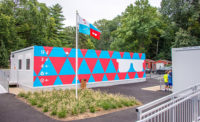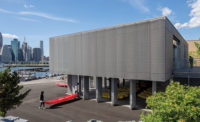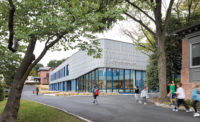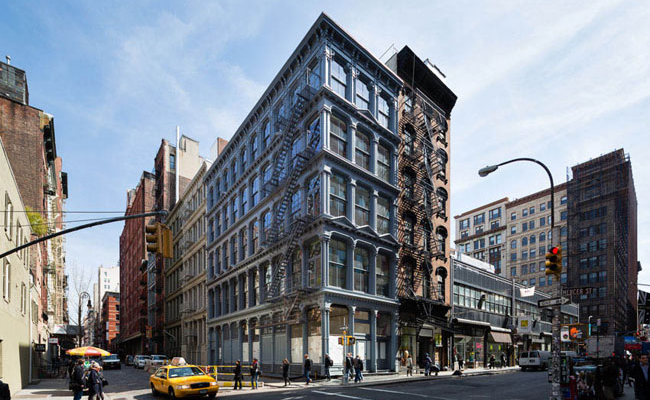Judd Home and Studio by Architecture Research Office
New York City




















































Architects & Firms
While he was redefining the boundaries of art in the 1960s, ’70s, and ’80s, Donald Judd reconfigured 101 Spring Street, his New York City home and studio, into a supersized piece of sculpture. Judd, who bought the 1870 cast-iron building in SoHo in 1968 for $68,000, transformed the industrial relic into an architectural version of his iconic boxes. He treated it as a five-story laboratory for displaying art, both his own and that of friends such as Dan Flavin, Frank Stella, and John Chamberlain. In the process, it became a vibrant hub of the art scene that blossomed in SoHo in that era. But as the area changed in recent years from art center to upscale shopping mall, 101 Spring stood suspended in time, a somewhat forlorn reminder of the days before Prada, Banana Republic, and Uniqlo changed the neighborhood.
Additional Content:
Jump to credits & specifications
In 2005 the Judd Foundation—including the artist’s son, Flavin Judd, and daughter, Rainer Judd—decided to restore 101 Spring, which remained a repository of the artist’s work after his death in 1994, and open it to the public for the first time. The project posed complex challenges in terms of bringing the building up to code and accommodating visitors. “We wanted to retain the character of a house and studio,” says Michele Saliola, director of programs for the foundation. “We didn’t want it to feel like a museum.”
The project’s scope encompassed both major work on the building’s exterior and radical surgery on its interiors. Adding all the new mechanical systems meant “essentially inserting a new building inside the existing one, while making everything invisible,” explains Adam Yarinsky, the principal in charge of the project for Architecture Research Office (ARO), the firm overseeing the renovation.
Working with Walter B. Melvin Architects (exterior restoration) and Robert Silman Associates (structural engineering), ARO restored the building to the look of its 1970s glory days as a hotbed of artistic creation, not its original 1870s sweatshop mode—a decision approved by New York’s Landmarks Preservation Commission. They repainted it the color Judd used (battleship gray), not the cream tone from the 19th century. Inside, they kept the fluid, open areas Judd created for his work and family. They even restored a secret cupboard-like space tucked under the building’s main stair on the second floor, which Rainer revealed to this writer on a recent visit and explained was used by her and her brother to put on puppet shows. ARO inserted restrooms and offices for the Judd Foundation in the cellar and meeting rooms in the subcellar, with restored glass blocks in the sidewalk bringing daylight to both lower levels. A new steel-plate stair at the north end of the building provides access to the two floors below the street.
On the exterior, Robert Bates of Walter B. Melvin Architects oversaw the work of stripping and restoring in place the cast-iron columns, removing and restoring all window frames and spandrel panels, and recasting 320 pieces of architectural ironwork such as broken capitals and cornices. He replaced all the glass above the first floor with insulated double glazing, using restoration glass that imitates the original on the inside and low-iron glass on the outside.
To accommodate a new air-handling system, sprinkler pipes, electrical conduit, and security and fire alarms, ARO waged a stealth architectural insurgency on the original building envelope—finding ingenious ways of weaving new mechanical equipment behind walls and in small spaces stolen from old uses. Some of that space was liberated by placing major mechanical equipment on the roof, which had to be rebuilt with new steel structural elements to support the weight.
Walking through the building now, you feel Judd’s presence everywhere—from the wood dining table and chairs he made himself to the drawing tools still spread out on his desk. It’s a little creepy, but in the same way that any house museum is. Judd believed that each floor should have a singular function, so you find cooking/eating facilities on the second floor, his studio on the third, a big space for socializing on the fourth, and places for sleeping on the fifth. The first floor, which the artist often used for meeting with students, will now host talks, parties, and other events—the only floor that will have a flexible role.
Judd saw history as something to be engaged, not treated as an artifact, says Yarinsky. ARO took a similar approach in renovating 101 Spring, preserving the worn treads of the wood stair running along the east edge of the building, for example, while inserting a new pivoting glass-and-steel door in the below-grade offices. On the fourth floor, the firm faced a tricky problem of maintaining the flowing space around the stair landing where Judd had removed partitions. To keep the area open while meeting fire codes, ARO devised a pair of smoke baffles set into existing walls, elements that swing or spring into action only if there’s a fire. As with so much of what the firm did on this project, Yarinsky hopes no one will notice the architects’ clever solution.
Surrounded by the frenetic shopping culture of today’s SoHo, 101 Spring will not magically return the area to its heyday as an arts mecca. But with the Judd Foundation now in its cellar and the public allowed inside, it will stand as an active lesson about a key moment in modern art.
Completion Date: June 2013
Gross square footage: 14,500 square feet (including below grade levels)
Total construction cost: Withheld
CreditsOwner: Judd Foundation Project Team: Carolyn Carson, Ben Cheah, Barbara Hunt McLanahan, Christopher Longfellow
Architect: Architecture Research Office Personnel in architect's firm who should receive special credit:
Engineer(s): Structural: Robert Silman Associates (Edward Meade [Principal], Ben Rosenberg)
Lighting: Richard J. Shaver Architectural Lighting Acoustical: Arup Exterior Restoration:
Owner’s Representative: Levien & Company
Construction Manager: F. J. Sciame Construction Co, Inc. (Robert Ware [Project Executive], Jay Gorman, John Crocco [Project Managers], Robert Werner [Site Superintendant]) |
SpecificationsStructural system Façade Cast Iron: Robinson Iron Corporation Structural Steel: Maspeth Welding Vault Lite Cast Iron: Antique Cast Iron
Exterior cladding Masonry & Concrete: Baroco Contracting; Long Island Concrete
Roofing Universal Services Group
Windows Wood frame: Artistic Windows and Doors Window Treatment:
Glazing Glass: Competition Metals Skylights: Universal Services Group
Doors Wood doors: Artistic Windows and Doors Fire-control doors, security grilles: McKeon Door Company
Hardware Finish Hardware: Nanz
Interior finishes Architectural Woodwork: Bauerschmidt and Sons Millwork: Humboldt Woodworking Painting (Exterior and Interior) and Decorative Plaster: Creative Finishes Floor and wall tile: Daltile (restrooms)
Conveyance Elevators: Metropolitan Elevator
Other unique products that contribute to sustainability: 101 Spring Street is a historic structure that is exempt from the energy code. Also, the scope of the project, historic preservation with very limited interior work, made it an inappropriate candidate for LEED. Notwithstanding these limitations, the project entailed a significant improvement to the exterior envelope, including added insulation to the roof and walls, new insulated window glass (with Low-E coating) and new tighter-fitting windows. Also, the original oil-fired boiler and steam heating were completely replaced with a new heating system using high-efficiency natural gas boilers, hot water heating and modern temperature controls. These measures reduce energy consumption.
Add any additional building components or special equipment that made a significant contribution to this project: Carpentry: Cord Contracting |
































